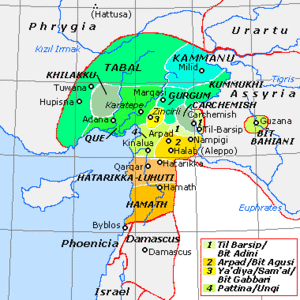Ištuanda
Ištuanda | |||||||
|---|---|---|---|---|---|---|---|
| Early 1st millennium BCE ?–Unknown | |||||||
 Ištuanda among the Syro-Hittite states | |||||||
| Capital | Ištuanda | ||||||
| Common languages | Luwian | ||||||
| Religion | Luwian religion | ||||||
| Government | Monarchy | ||||||
| King | |||||||
• r. c. 738 BC – c. 732 BC | Tuḫamme | ||||||
| Historical era | Iron Age | ||||||
• Established | Early 1st millennium BCE ? | ||||||
• Disestablished | Unknown | ||||||
| |||||||
| Today part of | Turkey | ||||||
Ištuanda (Neo-Assyrian Akkadian: 𒌷𒄑𒌅𒀭𒁕[1][2]) or Ištunda (Neo-Assyrian Akkadian: 𒌷𒅖𒌅𒌦𒁕[3]) was a Luwian-speaking Syro-Hittite state which existed in the region of Tabal in southeastern Anatolia in the Iron Age.
Location[edit]
Ištuanda was located in northern Cappadocia, in the northwestern part of the Tabalian region close to the kingdom of Atuna and near what is presently Aksaray.[4][5][6]
History[edit]
Bronze Age[edit]
The territory that later became Ištuanda might have corresponded to region which was referred to in Hittite texts from the Late Bronze Age as Wasuduwanda (𒌷𒉿𒋗𒁺𒉿𒀭𒁕[7]),[4] which was the site of a shrine to the goddess Ḫepat.[8]
Iron Age[edit]
By c. 738 BC, the Tabalian region, including Ištuanda, had become a tributary of the Neo-Assyrian king Tiglath-pileser III, possibly after his conquest of Arpad over the course of 743 to 740 BC caused the states of the Tabalian region to submit to him, or possibly as a result of a campaign of Tiglath-pileser III in Tabal.[9][10][11]
Consequently, in 738 and 732 BCE, the king Tuḫamme of Ištuanda was one of the five rulers of the Tabalian region who paid tribute to Tiglath-pileser III.[4][5]
Around c. 710 BCE, Ištuanda and the nearby Tabalian state of Atuna jointly attacked and occupied some of the cities of Bīt-Burutaš which the Neo-Assyrian king Sargon II had handed over to his loyal vassal, the king Warpalawas II of Tuwana.[12][4][13][5][6]
List of kings of Ištuanda[edit]
- Tuḫamme (Neo-Assyrian Akkadian: 𒁹𒌅𒄩𒄠𒈨;[14][15] r. c. 738 BC – c. 732 BC)
References[edit]
- ^ "Ištundaya [OF IšTUNDA] (EN)". State Archives of Assyria Online. Open Richly Annotated Cuneiform Corpus. Ludwig Maximilian University of Munich.
- ^ "Ištundaya [OF IšTUNDA] (EN)". Textual Sources of the Assyrian Empire. Open Richly Annotated Cuneiform Corpus. Ludwig Maximilian University of Munich.
- ^ "Ištundayu [OF IšTUNDA] (EN)". Textual Sources of the Assyrian Empire. Open Richly Annotated Cuneiform Corpus. Ludwig Maximilian University of Munich.
- ^ a b c d Bryce 2009, p. 338.
- ^ a b c Bryce 2012, p. 147.
- ^ a b Weeden 2023, p. 1000.
- ^ Kryszeń 2023.
- ^ Bryce 2009, p. 764.
- ^ Bryce 2012, p. 144.
- ^ Bryce 2012, p. 271.
- ^ Aro 2013, p. 389.
- ^ Bryce 2009, p. 93.
- ^ Bryce 2009, p. 726.
- ^ "Tuhamme [RULER OF IšTUNDA] (RN)". Ancient Records of Middle Eastern Polities. Open Richly Annotated Cuneiform Corpus. Ludwig Maximilian University of Munich.
- ^ "Tuhamme [RULER OF IšTUNDA] (RN)". Textual Sources of the Assyrian Empire. Open Richly Annotated Cuneiform Corpus. Ludwig Maximilian University of Munich.
Bibliography[edit]
- Aro, Sanna (2013). "Tabal". In Streck, Michael P. [in German]; Frantz-Szabó, Gabriella; Krebernik, Manfred [in German]; Bonacossi, D. Morandi; Postgate, J. N.; Seidl, Ursula [in German]; Stol, M.; Wilhelm, Gernot [in German] (eds.). Reallexikon der Assyriologie und Vorderasiatischen Archäologie (in German). Vol. 13. Berlin, Germany; New York City, United States: Walter de Gruyter. pp. 388–391. ISBN 978-3-110-30715-3.
- Bryce, Trevor (2009). The Routledge Handbook of the Peoples and Places of Ancient Western Asia: From the Early Bronze Age to the Fall of the Persian Empire. London, England: Routledge. ISBN 978-0-415-39485-7.
- Bryce, Trevor (2012). The World of The Neo-Hittite Kingdoms: A Political and Military History. Oxford, United Kingdom: Oxford University Press. ISBN 978-0-199-21872-1.
- Kryszeń, A. (2023). "Wašuduwanta". Hittite Toponyms. University of Mainz; University of Würzburg. Retrieved 16 April 2024.
- Weeden, Mark (2023). "The Iron Age States of Central Anatolia and Northern Syria". In Radner, Karen; Moeller, Nadine; Potts, Daniel T. (eds.). The Age of Assyria. The Oxford History of the Ancient Near East. Vol. 4. New York City, United States: Oxford University Press. pp. 912–1026. ISBN 978-0-190-68763-2.

